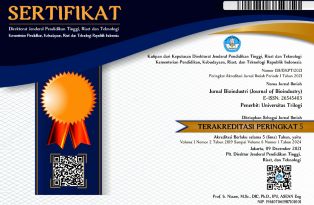PENGARUH METODE PENANAMAN HIDROPONIK DAN KONVENSIONAL TERHADAP PERTUMBUHAN TANAMAN SELADA ROMAINE DAN PAKCOY
Abstract
Cultivation of vegetables with the hydroponic method is able to produce plants with better quality values and is efficient in land use when compared to conventional ones. The comparison regarding the production and effectiveness of nutrient uptake between the two cultivation systems appears to be little studied. This study aimed to determine the effect of the planting method on the growth of romaine lettuce (Lactuca sativa) and pakcoy (Brassica rapa) through hydroponic and conventional methods. The study used a randomized block design (RBD) with two factors. The first factor is the cultivation method, namely conventional and hydroponic, while the second factor is the type of vegetable commodity, namely romaine lettuce and pakcoy. The results showed that hydroponic cultivation of romaine and pakcoy lettuce was able to absorb nutrients well, because it was proven that the results of parameters such as plant height, number of leaves, fresh weight and biomass content were superior. Hydroponic cultivation on romaine lettuce was 5.08 cm higher than conventional. Likewise, the hydroponic pakcoy was 9.12 cm higher than the conventional pakcoy. Hydroponic romaine lettuce has 3.39 leaves more than conventional, the same result also occurs in pakcoy plants. Meanwhile, fresh weight and biomass content of romaine lettuce and pakcoy in hydroponic systems are better than conventional systems.
Keywords
biomass;cultivation;nutrients;production;vegetables
Full Text:
PDFDOI: https://doi.org/10.31326/jbio.v4i2.951
Refbacks
- There are currently no refbacks.
Editorial Office:
Fakultas Bioindustri
Universitas Trilogi
Jl. TMP Kalibata No.1
Jakarta 12760
Copyright Notice:


2.png)






2.png)







